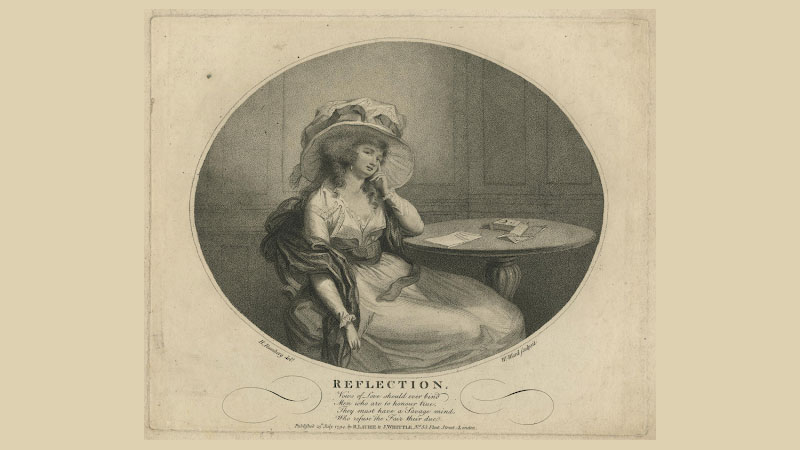How to write a love letter, eighteenth-century style

On Valentine’s Day 2022, expert in romantic love and letter-writing, Dr Sally Holloway, Vice Chancellor’s Research Fellow in History & History of Art at Oxford Brookes University, takes us back to a time before social media, texting and phone calls.
Dr Holloway shares some top tips for ‘old-school’ love letter writing in the eighteenth century.
Dr Holloway has researched romantic letter-writing for more than a decade, since first discovering a bundle of gilded love letters in the Bedfordshire archives in 2009.
First things first: what kind of paper should I use?
Dr Holloway: “Men and women writing love letters used the best quality paper that they could afford, meaning the thickest and whitest paper available. If they had the means, writers often used special paper that had been gilded around the edges using gold leaf.
“This was applied by booksellers, who rubbed the gold leaf over a special mixture of candied sugar, egg white, water, and a thick paste called Armenian bole, in order to moisten the page.1 It helped to give the letter that extra aesthetic appeal as a special gift from the writer.”
What types of sources should I draw upon for inspiration?
“Individuals composing love letters quoted a wide range of literary sources including passages from the Bible, the Book of Common Prayer, poems, novels, and plays. But they often didn’t attribute them directly, presuming that the recipient would understand the reference, therefore creating a shared bond between them. Popular sources included Shakespeare’s Romeo and Juliet, Troilus and Cressida, and The Tempest.
“This didn’t necessarily mean that writers had read the whole thing, though, as you could purchase texts such as The Beauties of Shakespeare which selected the most emotive passages for you!”
How much do I need to write?
“A love letter that is too short might indicate a lack of sincerity, or commitment to the recipient. This was especially true in the past, where recipients paid for postage once a letter arrived – hence it had to be worth paying for.
“Writers therefore used whole series of postscripts (written as ‘P.S.’) at the end of their letters in order to create the impression that they were unable to tear themselves away from the page. Some even used whole pages of postscripts to keep their letter going and going ad infinitum.”
Is there anything I should not say?
“Love letters represent a highly scripted genre, and are typically produced to follow certain stylistic conventions. This was partly because they used to be shared widely amongst friends and family, in order to gauge the suitability of a match, and were not the strictly private sources that we might assume today. Women in particular were always far more guarded and modest in their letters, as the pursuit of love was primarily a man’s responsibility, conceived of as a ‘sport’ or ‘game’.
“It is also incredibly rare to find any discussion of sex in love letters exchanged before marriage. The exceptions included women such as the feminist philosopher Mary Wollstonecraft, who wrote of the ‘live fire’ running about her features after an evening with her lover William Godwin in November 1796, causing a ‘blush of pleasure, as I adjusted my hair’.”2
What sorts of special touches can I add?
“Love letters function both as texts, and as treasured material objects in their own right. Writers therefore engaged in a whole range of rituals to imbue them with additional emotional value. These included spritzing them with fashionable exotic perfumes such as otto of roses, which was made using fresh rose petals.3
Before the invention of envelopes in the mid-nineteenth century, writers would fold their letter up and drip wax onto the fold, before imprinting it with a seal to close it shut.
“This gave them the opportunity to send covert messages using seals (such as ‘let’s live united’) without having to write it out directly. Many kissed their letters so that the lips of the sender and recipient could quite literally meet on the page, whilst others used them to enclose further tokens such as pressed flowers and locks of hair.”
What now?
“Once your letter had been handed to the post boy, now you had to wait. In an age before texts and emails enabled a much faster and more immediate intimacy, anxiety was an essential part of the process. Indeed, some of the first entries in the best-selling satirical text The Dictionary of Love were ‘Absence’ and ‘Anxiety’, for ‘The loyal subjects to the empire of love ever pay their tribute of anxiety’.”4
Dr Sally Holloway is the author of The Game of Love in Georgian England: Courtship, Emotions, and Material Culture (Oxford University Press, 2019).
1 Colin Mackenzie, ‘To Gild the Edges of Paper’, Five Thousand Receipts in All the Useful and Domestic Arts, Constituting a Complete and Universal Practical Library, and Operative Cyclopædia (London, 1825), pp. 24-5.
2 Todd (ed.) The Collected Letters of Mary Wollstonecraft (London, 2008), p. 375.
3 For a modern attempt to create otto of roses using a historic recipe, see: Victorian Otto Of Roses Tutorial
4 John Cleland, The Dictionary of Love. In which is contained, The Explanation of most of the Terms used in that Language (London, 1753).
